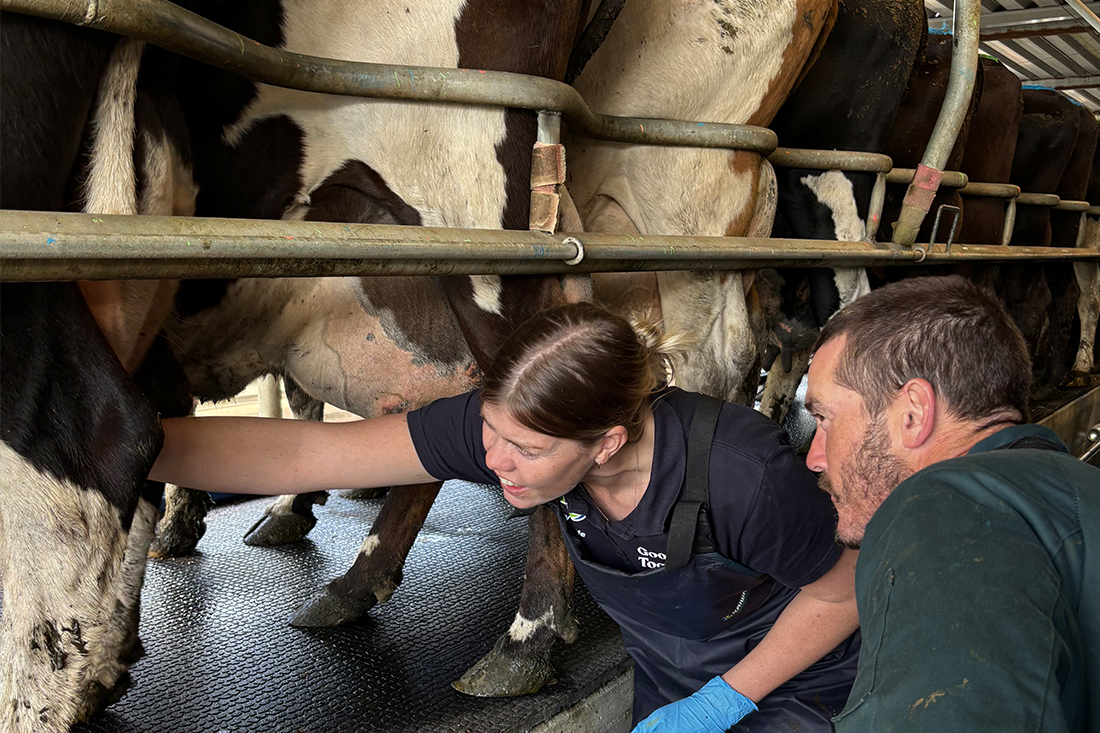The quantity of milk can drop off over summer. We look at how farmers can avoid production losses over this period.
Milking cows is a daily exercise for dairy farmers but the quantity of milk solids can vary throughout the year. Over the summer months, it is natural for milk production to decrease. There are many reasons for this including nutrition (less quality pasture available and lower metabolisable energy as a result), heat stress and decreasing levels after peak lactation.
However, there are many strategies farmers can employ to support production.
Fonterra Veterinary Programme Manager Mike Shallcrass says understanding the lactation curve can help farmers work out their best management strategies to ensure milk production is maintained over the summer months, in particular.
“Every cow ramps up quickly at the start of the season, then tapers off over the second half of the season. As New Zealand cows tend to calve roughly at the same time, it’s normal for the farm’s production curve to go up and down. Over summer, milk production will be dropping, but on many farms it will decline more steeply than the natural lactation curve because of invisible losses.
“It doesn’t happen every year but it’s common for grass to get drier and for the metabolisable energy (ME) to drop off, which in turn causes the production to drop. You can mitigate this with higher ME supplementary feed, a summer crop or summer tolerant pasture mix, or planned deferred grazing, but the key to success is anticipating and having a plan prepared so you aren’t scrambling for supplement or having to make do with lower quality feed.”
“Another cause of invisible milk loss, in the North Island in particular, will be cases of sub-clinical facial eczema. Depending on the severity of disease, cows can lose between 0.1 and 0.3kgMS/day, and that drop in production doesn’t recover once facial eczema season ends. Monitor spore counts and test the efficacy of your zinc supplementation to minimise the impact of facial eczema on production.”
“There is also heat stress to consider. If a cow is hot, she’s going to be spending time trying to cool down, not eating, and therefore not producing as much. The DairyNZ website is a great resource. It has guides on reducing heat stress, outlining the different options to support your cows over the hotter months. There are more options than only planting trees or building a herd home, there are simple management changes such as changing milking times or reduced frequency to avoid animals walking or standing in the yard at the hottest times of the day. However, your somatic cell count is likely to rise if you reduce milking frequency, so you’ll need to get it under control first.”
Milk Quality Improvement Visits
Fonterra Farm Source offers free milk quality improvement visits for its suppliers and produces an annual Farm Insights Report, specific to each farm. The Co-op’s Milk Quality Improvement team will work with farmers on-farm to assess practices and make recommendations on improving milking efficiency.
“Many farms will opt for once-a-day milking over summer, which is entirely achievable provided somatic cell counts are low enough. It is easier to find relief milking if you’re only milking once a day and it gives farmers the option to enjoy summer and have a bit of time off the farm. Getting the Milk Quality Improvement team on-farm can be very useful.”
Milk Quality Manager Terry Playle, who is part of Farm Source’s On-Farm Excellence Milk team agrees.
“Milk Quality Improvement visits can be instrumental in enhancing milk production, quality and efficiency. In the Waikato this year we’ve experienced a better winter and early spring so the environmental conditions have not been as challenging as last season. Over time we are seeing a gradual reduction in somatic cell counts with farmers having made practical changes on-farm over time such as reducing over-milking, better teat spraying, and improved teat condition. This is all great for reducing mastitis incidence and improving production,” says Terry.

Improving somatic cell count numbers
Terry says while environmental conditions generally improve on-farm over summer with less mud and manure contaminating udders, farmers still need to maintain high risk areas to minimise bacterial loading on udders and reduce new infections.
“Generally race and paddock conditions will improve but can still have effluent build-up on feed pads and nearby entry/exit races. These need to be managed and scraped regularly. Effective teat spraying is an absolute must. If a farmer can get the teat spray right, with the emollient levels, amounts and coverage right, then they’ll go a long way towards their goal of reducing new mastitis infections. It’s a year-round practice of monitoring both the volume usage per cow and achieving full coverage of all teats.
Terry advises farmers and their team to regularly assess teat condition and avoid over-milking, which is a common contributor to teat end damage.
“There’s only one way to get mastitis and that’s bacteria going up the teat canal. Damage to the teat end can in turn harbour more bacteria in that area and compromise the teat ends natural defence mechanism in stopping bacteria gaining entry. You cannot increase the risk of mastitis by under-milking a healthy cow, but you can indirectly by over-milking.”
To book your milk quality service visit, head to your local Farm Source store or visit nzfarmsource.co.nz/milkquality